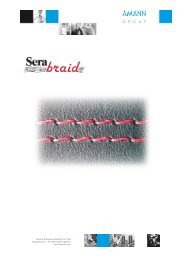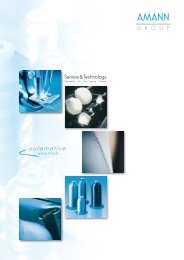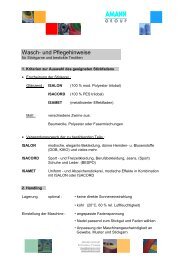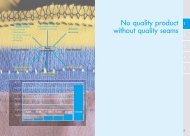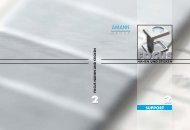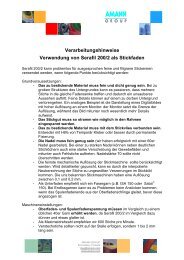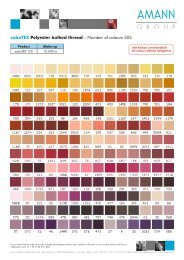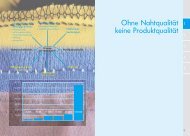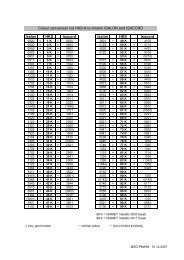Useful tips Serafil 200-2 - AMANN Group
Useful tips Serafil 200-2 - AMANN Group
Useful tips Serafil 200-2 - AMANN Group
Create successful ePaper yourself
Turn your PDF publications into a flip-book with our unique Google optimized e-Paper software.
<strong>Useful</strong> <strong>tips</strong> using <strong>Serafil</strong> <strong>200</strong>/2 as embroidery thread<br />
Following the below mentioned <strong>tips</strong>, <strong>Serafil</strong> <strong>200</strong>/2 can be used well for extremely fine<br />
and filigree embroideries.<br />
Basic requirements:<br />
- The material has to be fine and dense enough. By chunky structures of<br />
the fabric it might happen, that several stitches drop into the same weave.<br />
This causes improper appearance. Fine details of a motif can get lost on a<br />
tough ground fabric. An analogue imagination is the display of a picture of<br />
high resolution on a screen. The screen sets the possible maximum, even<br />
if the picture itself is more detailed.<br />
- The fabric has to be put into the frame as tight as possible.<br />
- The backing has to be fixed to the fabric. The use of temporary glue is<br />
possible, better is a permanent fusing.<br />
- The needle has to be fine enough. Our trials have successfully been<br />
done with a No. 8 needle (Nm 60). Besides needle holes in the fabric,<br />
displaced weaves and skip stitches might appear, if a bigger needle size is<br />
used. The maximum needle size is 10 (Nm 70).<br />
- The smallest possible mechanical resolution of the embroidery machine<br />
ought to be kept in mind. If the actual punch is more detailed, misaligned<br />
stitches can appear due to the recalculation (interpolation) of stitch details.<br />
Against our knowledge, the actual resolutions of the machines are about<br />
0,1 to 0,2 mm.<br />
- The use of a staple fibre yarn (such as ISA 150 or Saba C 150) as bobbin<br />
thread is advisable. During the use of endless filaments as bobbin thread it<br />
might happen at the first stitches, that the bobbin thread slips out of the<br />
needle thread loop, before the loop is tightened.<br />
Machine adjustments:<br />
- The tensions of needle and bobbin thread should be tightened as to<br />
the tensions during the use of the usual 40s embroidery thread. This is<br />
due to the finer and sloppier character of <strong>Serafil</strong> <strong>200</strong>/2.<br />
- We suggest 600 rpm as maximum speed for embroideries with <strong>Serafil</strong><br />
<strong>200</strong>/2<br />
- Tack stitches should not be done punctual. A small stitch length of 1 to 2<br />
mm is advisable.<br />
<strong>AMANN</strong> GROUP<br />
Embroidery Threads<br />
msg@amann.com<br />
www.amann.com
Note for digitizing:<br />
- Satin stitches with a width about 1 mm are possible.<br />
- Keep in mind the concrete size of the stitches during the digitizing. It is<br />
advisable to work with simple and defined shapes. In most cases all<br />
stitches of less than 0,5 mm can be cancelled.<br />
- For small letters special attention is necessary, hence our eye does not<br />
tolerate any discrepancies. Test runs and following hints will help you to<br />
achieve a convincing and proper result at small wordings quickly:<br />
o All arcs and curves (i.e. “O” or “”d”) should be digitized a little bit<br />
bigger, than the draft.<br />
o The width of satin stitches not below 1 mm<br />
§ rows of satin stitches (i.e. “I” or “H”) should be digitized a little<br />
shorter, than the draft.<br />
§ for this kind of small satin stitches, use a centric underlay<br />
stitch or cancel underlay stitches completely.<br />
§ gaps within one letter (i.e. the dot of the “i” or the bottom tail<br />
of the “e”) should be made larger, than the draft. Otherwise<br />
the “i” will read as “l” and the “e” will read as “o”.<br />
- For first trials a pattern digitized for a “standard” ticket no.40 embroidery<br />
thread can be used. The size should be reduced to 55% – 65% of its<br />
original size (without recalculating the stitches!). This size reduction is<br />
usually possible even in the embroidery machines operation unit without<br />
doing any changes to the program. The results might be that proper, that<br />
they can be used without any further digitizing. Otherwise, small alterations<br />
at the digitizing will be sufficient to make the design suitable for <strong>Serafil</strong><br />
<strong>200</strong>/2.<br />
<strong>Serafil</strong> <strong>200</strong>/2 corresponds to an embroidery thread ticket no. 75.<br />
For further assistance and technical advise please contact our hotline under<br />
+49 7143 277 219.<br />
<strong>AMANN</strong> GROUP<br />
Embroidery Threads<br />
msg@amann.com<br />
www.amann.com






